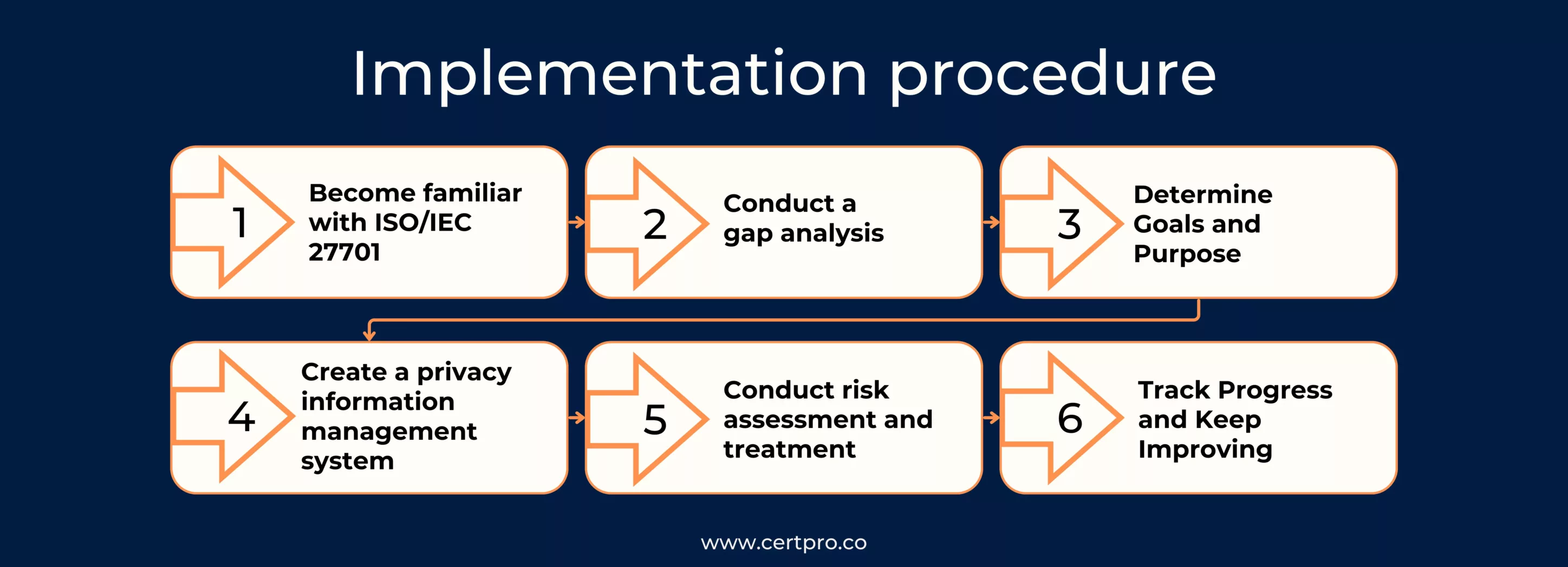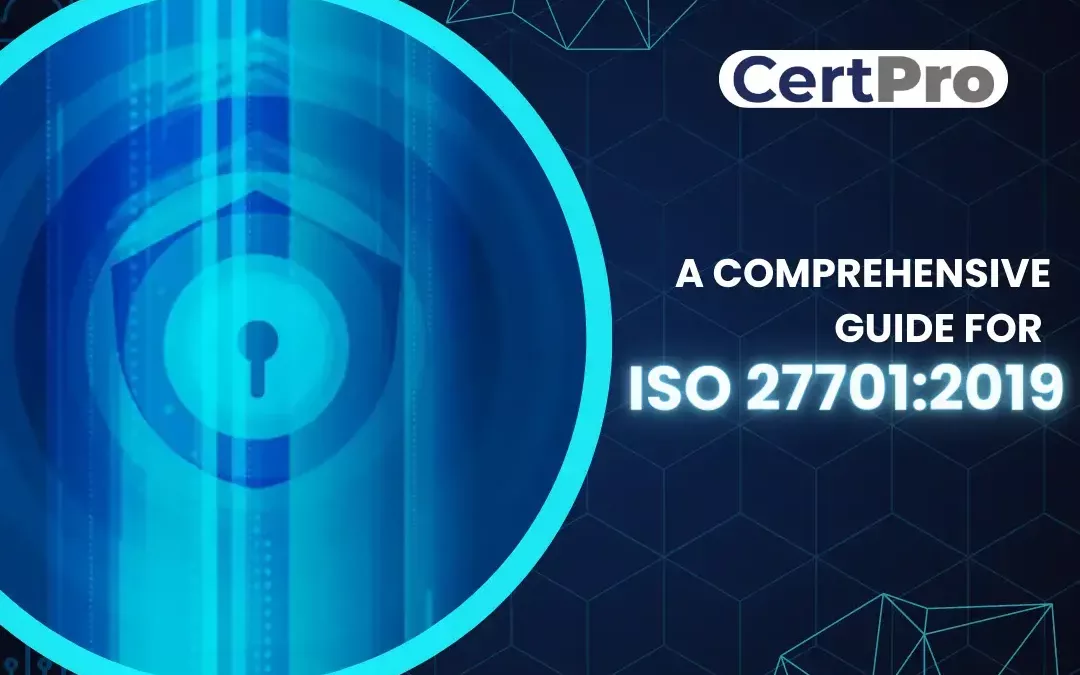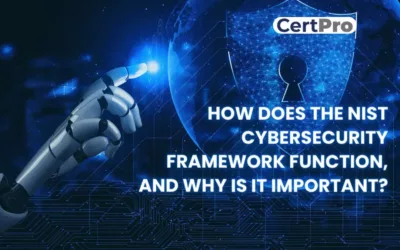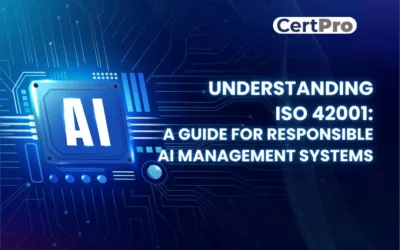Data privacy being crucial these days, it’s been a hectic task to store, protect, and even process the data. A framework has come into existence that helps with the detailed guidelines and requirements to process and keep data safe. The purpose of this framework is to provide a better plan to help your organization develop and maintain information systems that process privacy information.
27701:2019 is the new ISO standard that helps companies and organizations keep their data safe and protected. Any organization that processes personal data needs to understand this particular framework. It is a data privacy extension for ISO 27001. This newly published standard provides guidance to organizations on how to put systems in place to support compliance with GDPR.
In this article, we will delve into the world of ISO 27701:2019 and learn about its significance in ensuring data privacy and regulatory compliance, the key principles and requirements it encompasses, the benefits it offers to organizations, and practical implementation strategies to achieve ISO IEC 27701:2019 certification successfully.
WHAT IS ISO 27701, AND HOW DO COMPANIES BENEFIT FROM IT?
The International Organization of Standardization (ISO) has released the widely recognized international standard known as ISO 27001:2019. It provides guidelines for implementing a Privacy Information Management System (PIMS). It is also an extension to the supreme ISO 27001 standard, which is an international standard for information security management systems.
The key objective of 27701:2019 is to help organizations implement, establish, maintain, and continually improve a PIMS. It especially focuses on the protection of personal data. This particular standard aims to assist organizations in managing privacy risks and demonstrating compliance with privacy laws and regulations, which particularly involve the GDPR requirements.
THE IMPORTANCE OF ISO 27701:2019
In this era of high-profile data breaches and growing concerns about data privacy, ISO 27701:2019 plays a crucial role in addressing these challenges. By implementing this ISO standard, organizations can enhance their privacy management practices, establish a systematic approach to managing privacy risks, demonstrate compliance with privacy regulations, and build customer trust.
Enhancing privacy management: ISO 27701:2019 provides a methodical approach to managing the risks that may affect data privacy and protecting personal data. It helps organizations identify and assess privacy risks, implement appropriate controls, and establish privacy policies and procedures.
Ensuring regulatory compliance: This standard is intended to be compliant with privacy laws like the GDPR. The 27701:2019 standard enables enterprises to show compliance with privacy laws by assisting them in comprehending and satisfying their legal duties.
HOW DO ISO 27001 AND ISO 27701 DIFFER FROM EACH OTHER?
ISO/IEC 27001 and ISO/IEC 27701 are related standards that address information security management and privacy information management, respectively. While there is a significant overlap between the two standards, they have distinct focuses and objectives.
We will be mentioning a few key differences between these two standards:
Scope and focus: The ISO/IEC 27001 standard offers a framework for managing the security of information assets inside an organization and focuses primarily on information security management systems (ISMS). It covers the complete information security management process and a wide variety of information security measures.
Contrarily, ISO/IEC 27701 focuses on privacy information management systems (PIMS) and offers recommendations on how businesses should handle personally identifiable information (PII) and abide by privacy laws. It adds privacy considerations to the ISO/IEC 27001 criteria and controls.
Privacy considerations: Although it tackles information security, ISO/IEC 27001 does not specifically address privacy obligations. Although certain privacy-related settings are there, privacy is not the main goal.
ISO 27701:2019 elaborates on the privacy-related measures required to safeguard personal data and especially tackles privacy management. It offers a structure for putting controls and procedures in place to manage privacy risks and abide by privacy laws like the General Data Protection Regulation (GDPR).
Integration with other management systems: Utilizing a standard framework known as Annex SL, ISO/IEC 27001 is intended to be readily linked with other management systems, such as quality management (ISO 9001) and environmental management (ISO 14001).
In addition to ISO/IEC 27001, ISO/IEC 27701 can be incorporated into an already-existing ISMS. It makes use of the controls and organizational framework of ISO/IEC 27001 and adds particular specifications for privacy management.
HOW TO ACHIEVE ISO 27701: WHAT ARE THE REQUIREMENTS?
It can be difficult to achieve compliance with ISO/IEC 27701, the Privacy Information Management System (PIMS), but it ultimately depends on a number of variables, such as the organization’s current privacy policies, resources, and dedication to privacy management. The key steps to follow in the process of achieving ISO 27701:2019 are:
1. Requirements:
Are you currently equipped with an information security management system that adheres to the ISO/IEC 27001 standards? If your answer is yes, then congratulations! You are already well-prepared to embark on your journey with ISO/IEC 27701.
The ISO/IEC 27701 Privacy Information Management System (PIMS) encompasses eight distinct clauses and six annexes, encompassing comprehensive guidance and requirements. This framework provides controls for managing personally identifiable information (PII), along with mapping to relevant standards and the GDPR.
To ensure seamless implementation, it is imperative that you thoroughly understand the instructions, specifications, and controls outlined in ISO/IEC 27701. It is equally important to ensure their proper application throughout your organization.
2. Implementation procedure:
The Privacy Information Management System (PIMS), defined by ISO/IEC 27701, must be implemented with meticulous preparation, commitment, and a methodical approach. Here is a step-by-step manual to help you successfully complete the implementation process:
Step 1: Become familiar with ISO/IEC 27701
Study the ISO 27701:2019 standard in detail to get a thorough grasp of its requirements, controls, and recommendations. Learn its provisions, annexes, and the privacy information management principles that underlie them.
Step 2: Conduct a gap analysis
To determine where your present information security management system (ISMS) matches ISO/IEC 27701 and where more steps are required, do a gap analysis. Examine the current procedures, rules, and controls in place and compare them to ISO/IEC 27701’s specifications.
Step 3: Determine Goals and Purpose
Establish the goals for adopting ISO/IEC 27701:2019 within your organization. Establish the implementation’s parameters, including the systems, departments, and business processes that will be incorporated into the PIMS framework. Make sure your PIMS’s boundaries are well-defined and that they are in line with the objectives of your entire business.
Step 4: Create a privacy information management system (PIMS)
Create and construct a privacy information management system that complies with ISO/IEC 27701:2019. To secure personally identifiable information (PII), rules, procedures, and controls must be established. To achieve a unified strategy, think about connecting your PIMS with your current information security management system (ISMS).
Step 5: Conduct risk assessment and treatment
To find possible privacy risks and weaknesses inside your firm, do a thorough risk assessment. To reduce or eliminate these risks, use the best risk treatment strategies and put controls in place. Verify that the controls adhere to ISO/IEC 27701’s standards.
Step 6: Track Progress and Keep Improving
Establish measurement and monitoring procedures to evaluate the performance of your PIMS. Review and assess its performance often, pinpoint opportunities for development, and take remedial action as required. Keep up with changing laws and standards while always monitoring new privacy concerns.
3. ISO 27701 certification:
For ISO/IEC 27701:2019 certification, a particular procedure that involves working with an approved certification authority must be followed. Follow these steps to become certified:
a) Prepare your Privacy Information Management System:
Make sure that your organization has implemented and integrated the requirements of ISO 27701 into your PIMS. This process also includes establishing the policies, controls, procedures, and documentation to manage and protect personally identifiable information (PII) in compliance with the standard.
b) Choose an Accredited Certification Body:
Do your research and pick an accredited certification body that has been given the go-ahead to certify businesses as conforming to ISO/IEC 27701. A list of recognized certification bodies in your area can be obtained from accreditation organizations like the International Accreditation Forum (IAF) or other national accreditation agencies.
c) Stage 1 Audit:
A Stage 1 audit usually precedes the certification procedure. The certification body will examine your PIMS paperwork during this audit and determine if it is ready for the main certification audit. The auditor will evaluate the application of important controls and confirm that the required systems, controls, and procedures are in place.
d) Stage 2 Audit (Certification Audit):
The certification body will carry out the Stage 2 audit, also known as the certification audit, after your firm has successfully completed the Stage 1 audit. This audit entails a comprehensive analysis of your PIMS installation, which includes interviews, a study of the supporting documentation, and on-site inspections. The auditor will assess the effectiveness and compliance of your PIMS with ISO/IEC 27701 requirements.
e) Surveillance Audits:
The certification authority will periodically perform surveillance audits on you as a condition of your certification. These audits make sure that your company continues to follow ISO/IEC 27701 regulations. Depending on your organization’s risk profile and the certification body, the frequency and extent of surveillance audits may change.
On an important note, It’s vital to remember that depending on the certification authority and local regulations, the specific certification procedure may differ slightly. For further information and direction on their particular certification procedure for ISO/IEC 27701, it is essential to communicate with the chosen certification authority.

CertPro: SIMPLIFYING ISO 27701 2019 COMPLIANCE FOR ORGANIZATIONS
Navigating the intricacies of ISO/IEC 27701 compliance can be a daunting task for organizations. However, with the assistance of CertPro, a comprehensive compliance solution, organizations can simplify the process and achieve ISO/IEC 27701 certification with confidence.
In the complex landscape of privacy information management, CertPro serves as a trusted partner for organizations seeking ISO/IEC 27701 compliance. With its tailored guidance, expertise, and comprehensive solutions.
FAQ
IS ISO/IEC 27701 CERTIFICATION MANDATORY?
ISO/IEC 27701 certification is not mandatory, but it is a vital indicator of a company’s dedication to privacy management and adherence to global standards. It improves confidence and trust among stakeholders and can give businesses in privacy-sensitive industries a competitive edge.
HOW LONG DOES THE ISO/IEC 27701 COMPLIANCE PROCESS TYPICALLY TAKE?
The duration of the ISO/IEC 27701 compliance process varies based on the organization’s size, the complexity of its operations, its current privacy management procedures, and the availability of its resources.
HOW LONG IS AN ISO/IEC 27701 CERTIFICATION VALID?
The certification for ISO/IEC 27701 is normally good for a set time frame, frequently three years. Organizations are subject to surveillance audits throughout this period to guarantee continued compliance. Organizations can extend their certification through recertification audits after the certification term has ended.
DOES ISO/IEC 27701 ADDRESS SPECIFIC TECHNOLOGIES OR INDUSTRY SECTORS?
According to ISO/IEC 27701, no particular technologies or business areas are highlighted. Regardless of their business or the technological solutions they employ to process personally identifiable information (PII), it offers a flexible framework that may be applied to varied companies.
IS ISO/IEC 27701 APPLICABLE ONLY TO ORGANIZATIONS OPERATING IN SPECIFIC REGIONS?
The international standard ISO/IEC 27701 is applicable on a worldwide scale. It is intended to assist enterprises all over the world, regardless of their location or the privacy laws they are subject to, in establishing and maintaining efficient privacy management systems.

About the Author
GANESH S
Ganesh S, an expert in writing content on compliance, auditing, and cybersecurity, holds a Bachelor of Arts (BA) in Journalism and Mass Communication. With a keen eye for detail and a knack for clear communication, Ganesh excels in producing informative and engaging content in the fields of compliance, auditing, and cybersecurity, with particular expertise in ISO 27001, GDPR, SOC 2, HIPAA, and CE Mark.
HOW DOES THE NIST CYBERSECURITY FRAMEWORK FUNCTION, AND WHY IS IT IMPORTANT?
Emerging cyber threats make cybersecurity an essential consideration for organizations handling and managing data. In this regard, the NIST cybersecurity framework applies to improving your cybersecurity program. It is a set of guidelines that helps improve your...
UNDERSTANDING ISO 42001: A GUIDE FOR RESPONSIBLE AI MANAGEMENT SYSTEMS
The invention of artificial intelligence (AI) has changed the operational processes of many industries. However, the rapid growth of technology increases ethical, security, and privacy-related concerns. Therefore, the International Organization for Standardization...
EUROPEAN UNION’S ARTIFICIAL INTELLIGENCE ACT: HOW THIS GROUNDBREAKING LAW AFFECTS YOUR BUSINESS
Nowadays, Artificial Intelligence (AI) is transforming our lives exceptionally well. AI is now streamlining healthcare services, providing virtual assistance, and fulfilling queries. Technologies have boons and curses. Similarly, AI creates many concerns about...




